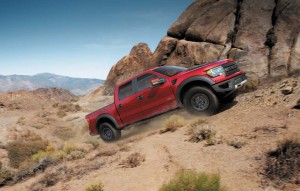
Ford bucked the sales downturn in September enjoying a 6% increase with F-Series leading the way to the rise.
With the government shutdown looming and the economy sputtering, demand for new cars, trucks and crossovers fell back to earth in September after a torrid summer sales spurt. It would be the first year-over-year downturn in 27 months of recovery.
With demand sliding, makers also had to rein in the price increases of recent months and, in some cases, boost rebates and other incentives, halting a rapid climb in the prices American motorists have been paying in recent months.
But while General Motors was one of several makers to post a downturn in sales compared to last year, Ford and Chrysler both were able to deliver unexpectedly strong increases for the month. The two makers were able to ride the continuing surge in demand for pickup truck sales buoyed by a modest revival in the U.S. housing market.
Ford, in fact, had its best September since 2006 with a 6% increase in the U.S., outpacing the industry and marking the maker’s 11th consecutive month of year-over-year sales increases.
“The combination of great styling, fuel economy and value delivered another solid monthly result for Ford in September,” said Ken Czubay, vice president, U.S. Marketing, Sales and Service, adding that the full-size “The F-Series keeps delivering, with our fifth-straight month surpassing the 60,000-vehicle mark and continuing as America’s best-selling vehicle.”
Chrysler Group eked out a 1% increase compared with sales in September 2012, marking the smallest of the Detroit maker’s best September since 2007 – Chrysler extending its streak of year-over-year sales gains to 42-consecutive months.
“Even though industry sales dipped during September, Chrysler Group still managed to eke out a slight sales increase for the month,” said Reid Bigland, Head of U.S. Sales.
The weak performance for September may not be as worrying as the numbers initially suggest, however. J.D. Power and Associates noted that there were several flukes to the industry calendar, resulting in fewer so-called “selling days,” while the bonuses of big Labor Day sales extravaganzas largely wound up being counted in the strong month of August’s numbers.
“Our dealers had two less selling days in September compared with a year ago, but they still outperformed the industry and extended our sales streak to 42-consecutive months of year-over-year sales gains,” suggested Chrysler’s Bigland, noting that Chrysler Group had four models that set sales records in September, the Jeep Compass and Patriot, and the Dodge Dart and Challenger.
Nissan Division sales finished at 77,828 units, a decrease of 5.6 percent. Sales of Infiniti vehicles totaled 9,040 units, down 4.3 percent.
While Ford and Chrysler might be celebrating, General Motors reported an 11% drop year-over-year. Retail sales were down 6% versus a year ago and fleet sales were down 27%. But adjusting for the quirky September calendar, GM officials put a more positive spin on the numbers, suggesting demand would have been up 2%.
While many foreign makers have yet to weigh in, Nissan reported a 5.5% sales decline for September. The core Nissan division was off 5.6%, with the high-line Infiniti marque sliding 4.3%.
Officials with the Japanese maker also tried to find a positive outlook for the month, projecting things should improve when new models – notably the Rogue compact crossover – reach market. “We expect that demand for these new products will continue to accelerate our sales momentum,” forecast Fred Diaz, Divisional Vice President, Sales & Marketing, Service & Parts for Nissan.
Despite steady demand for its diesel models, Volkswagen of America saw its sale slip by 2.6% during September.
“While September was an expectedly tough month for the industry, Volkswagen is seeing some stability as we are consistently pacing at a solid level of performance for the second year in a row, a level we haven’t seen in 40 years,” said Mark McNabb, chief operating officer, Volkswagen of America. “As we enter the last quarter of the year, I’m confident we can maintain this pace as our product mix improves and we increase the availability of our 2014 model year vehicles.”
Analysts are predicting industry sales will slip 3.8% once all makers report in for September, the first drop in 27 months. Deliveries for the first two days of September, including the Labor Day holiday, won’t contribute toward automakers’ tallies because they were counted in August figures.
(Automakers brace for sales slide. For more, Click Here.)
Mike Sprague, Kia vice president of communications, said September was a tough month for most automakers. Hyundai said it posted its “second best” sales for September and its daily rate of sales increased by 4% as it continued to shake off the impact of a strike that had cut factories across South Korea.
Makers had been taking advantage of the spring-summer sales surge to trim back incentives and boost MSRPs, hoping to cover costs boosted by the steady increase in standard equipment demanded both by customers and government regulators over recent years. But September forced makers to take a bit of a break, increasing incentives and holding back on price increases.
(Click Here to read about compact cross-overs becoming a full-size segment.)
The estimated average transaction price for light vehicles sold in the United States was $31,604 in September 2013, up a modest $32 from the previous month and down $37 year-over-year, according to Kelley Blue Book, a provider of new and used car information.
“Transaction prices remained fairly flat compared to last month as manufacturers were trying to empty dealership lots from 2013 model-year inventory as 2014 models were arriving in showrooms,” said Karl Brauer, KBB senior analyst.
Paul A. Eisenstein contributed to this report.
